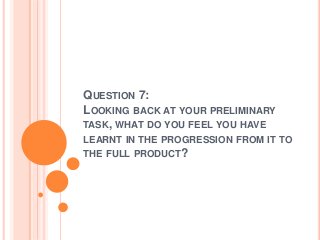
Question 7
- 1. QUESTION 7: LOOKING BACK AT YOUR PRELIMINARY TASK, WHAT DO YOU FEEL YOU HAVE LEARNT IN THE PROGRESSION FROM IT TO THE FULL PRODUCT?
- 2. PRODUCTION SKILLS Creating s preliminary task was very helpful, as it allowed us to learn new, and improve on current production skills, that would help us greatly when it came to making our final opening sequence. For example, we learnt how to: Effectively use a tripod to gain better control and use of the camera, and reduce the amount of wobble in shots. In our preliminary task, we only used a tripod for some shots. When editing, we found that the shots taken with a tripod were of a higher quality – less wobble – therefore we learnt that for our final sequence, we should use a tripod for all shots (except those where we wanted to have a Steadicam effect). This allowed us to make our final sequence as professional as possible, so that an audience could watch it and think it is a real film. Better editing skills. Our preliminary task allowed us to begin to learn how to use Premiere Pro, and how to use it efficiently and effectively. This meant that when it came to editing our final sequence, we already had a grasp of how to add transitions and effects, and how to remove/change the volume of audio. This meant that we could be more time efficient with our editing, as we could just get on with it, with as little fuss as possible. It also meant that the overall quality of our product was improved, as we knew what effects or transitions would be best to create an effective title sequence.
- 3. IMPORTANCE OF RESEARCH Before planning and creating our final sequence, it was vital that we undertook research on films in our chosen genre. This meant that we could find out the common conventions within the films and their title sequences. With this information, it allowed us to plan and create a more believable psychological horror film, as we know what the conventions are and create our sequence based on these. (We decided to use the common conventions, rather than challenge them).
- 4. IMPORTANCE OF PLANNING As well as researching our genre, we had to carefully plan out each frame, the character profiles, our filming and our font/soundtrack. Producing detailed storyboards, character profiles (with costume and props), location recces and a titles timeline was vital, as it meant that we had a structure to work form when it came to filming, so we weren’t thinking of all of the scenes and characters at the very last minute. This therefore meant that few could be more efficient with our filming, by getting all the shot we need in as few shoots as possible, which saves more time for creating a higher quality final sequence through editing. Also it was important to plan our soundtrack (diegetic and non-diegetc), as our film is a psychological horror, so having the right balance between eerie diegetic and non-diegetic sound was essential to create a creepy, unnerving atmosphere, that would set the tone up for the audience, for the rest of the film. Our soundtrack – Atrium Carceri - Thermographic Components. This soundtrack definitely helped to set up an unnerving, frightening atmosphere
- 5. MANAGING TIME To ensure that we created a title sequence of the highest possible quality, we had to use our time effectively when filming and editing. We got all of our filming done in only two shoots. This was very helpful, as it gave us more time to focus on editing our rough edits and final sequence, so that we had the opportunity to fine tune the sequence so that it was the best it could possibly be. As well as this, we also got the bulk of our editing (getting the right shots, the right length, in the right place) done quite quickly and efficiently . This meant that we had more time to improve small, lower quality parts of our sequence. It also meant that we could reshoot some shots, and gain audience feedback on our rough edits, to make sure that we kept improving our sequence to make it as effective as possible.